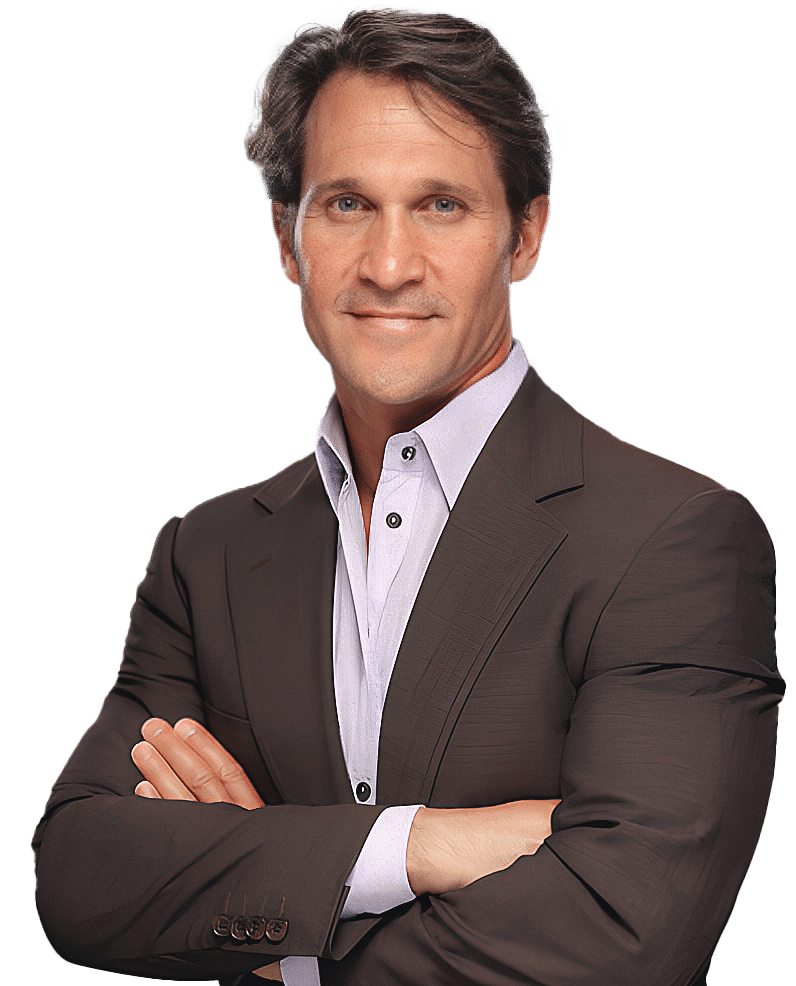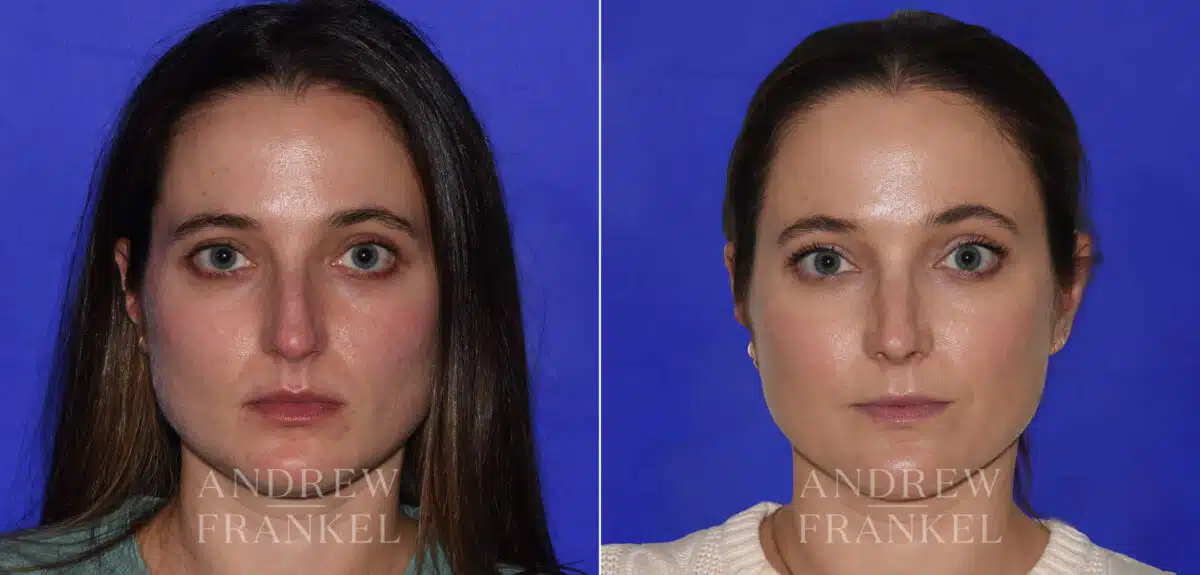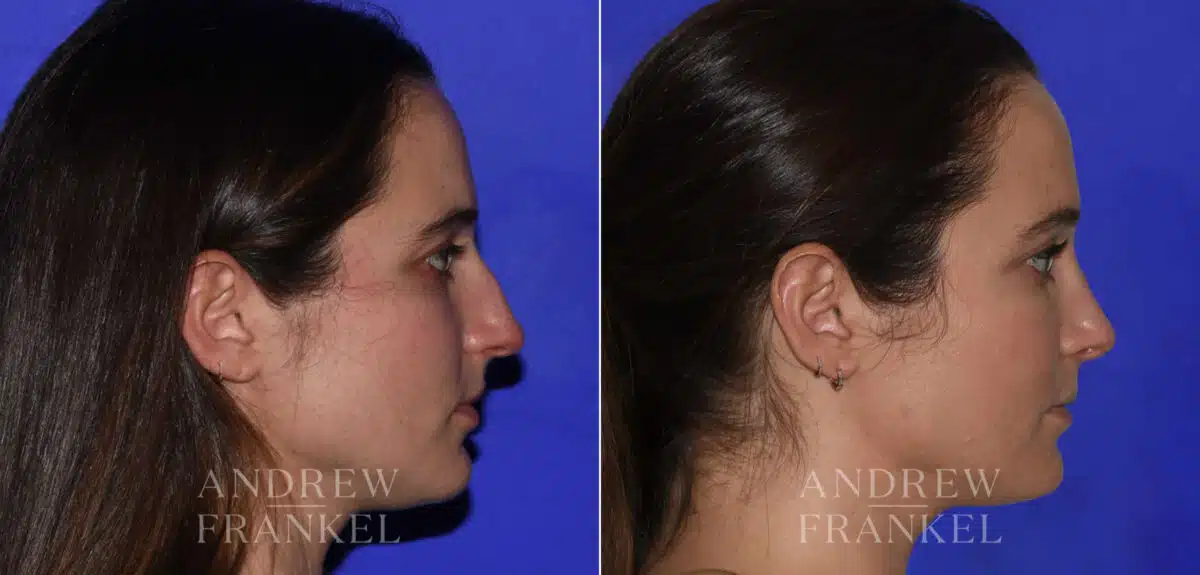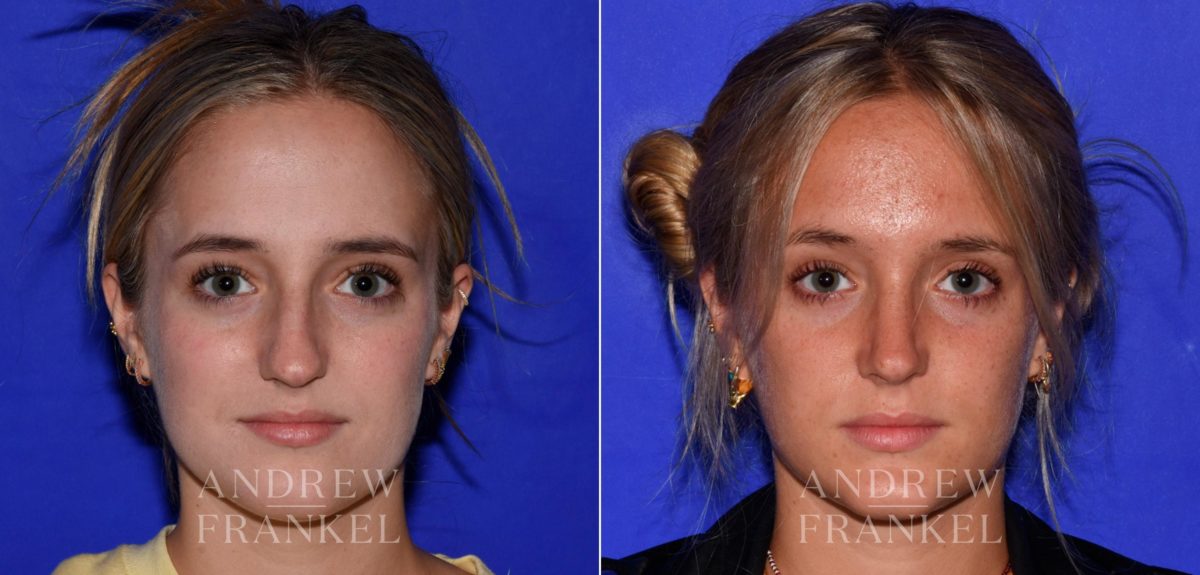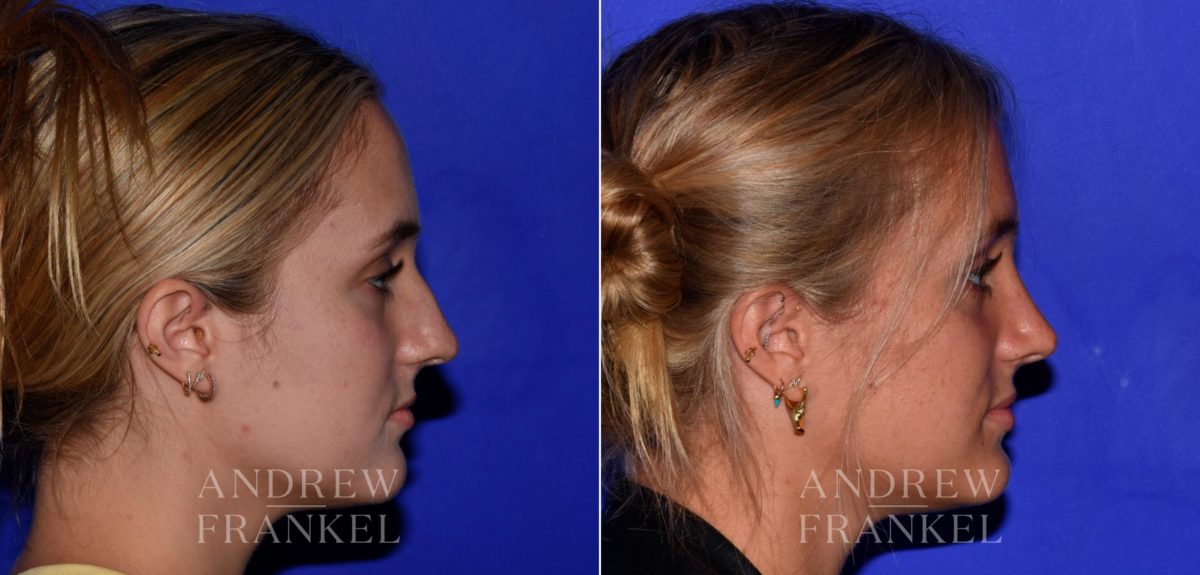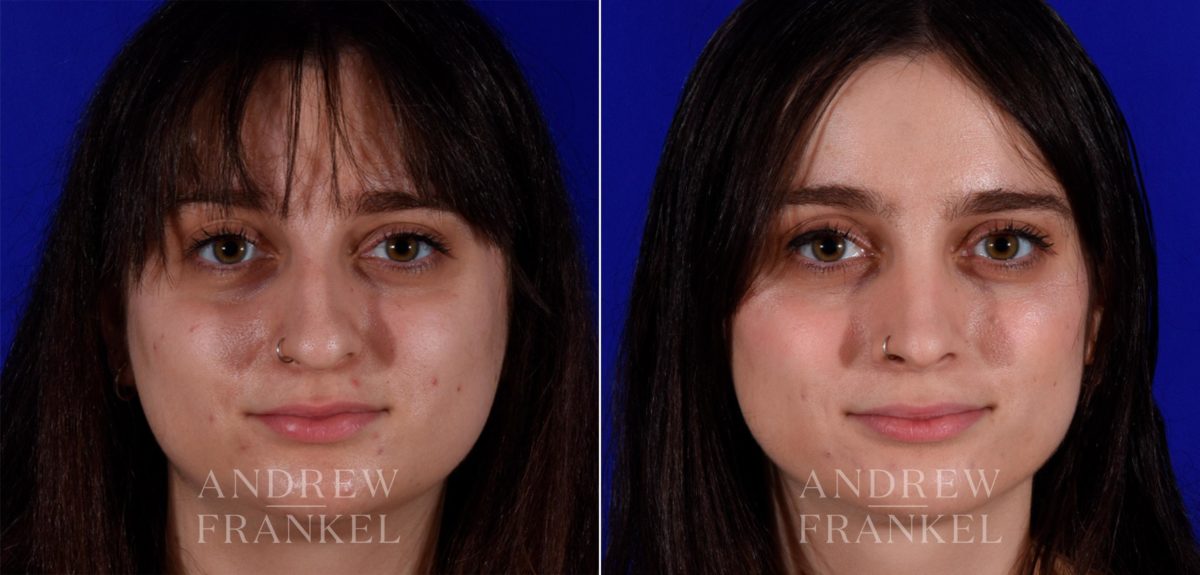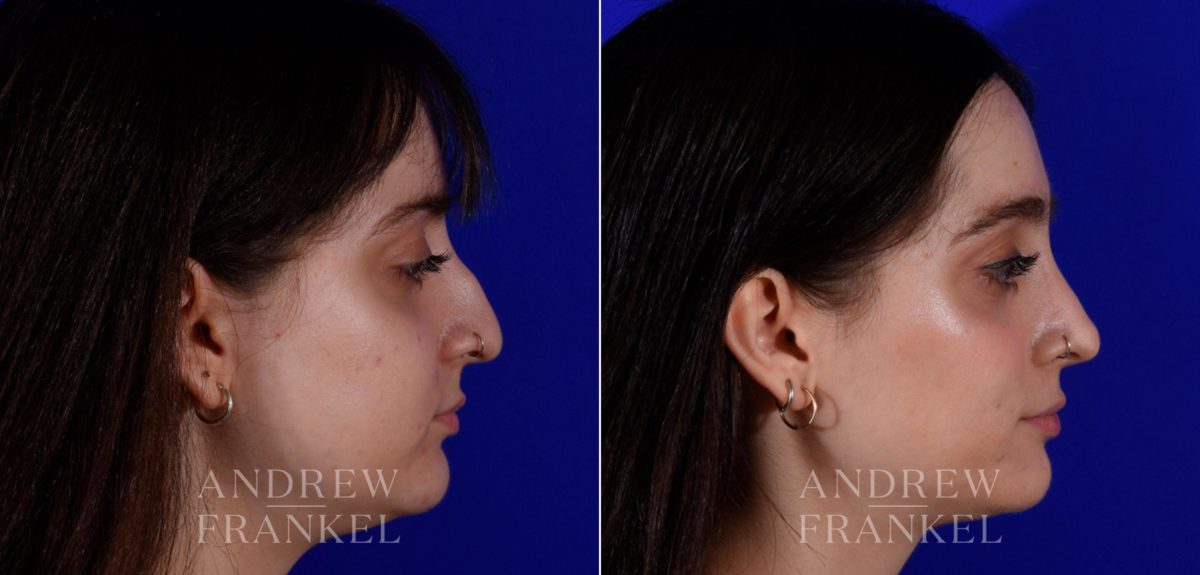
Rhinoplasty in Beverly Hills, CA
Transform your profile with Dr. Andrew Frankel’s expert rhinoplasty services in Beverly Hills. Specializing in both aesthetic enhancement and functional refinement, our Beverly Hills clinic promises exceptional results. Dr. Frankel, a distinguished Beverly Hills plastic surgeon, skillfully reshapes your nose, ensuring it complements your unique facial features. Experience the art of rhinoplasty with a surgeon trusted for his precision and expertise in Beverly Hills.
Transform Your Look with Expert Rhinoplasty in Beverly Hills
Seeking a perfect harmony between your facial features? Rhinoplasty is more than just a plastic surgery procedure; it’s the key to unlocking self-confidence and breathing comfort. Dr. Andrew Frankel excels in reshaping nasal structures, ensuring that rhinoplasty patients walk away with a newfound appreciation of their reflection.

Boosted Self-Esteem
Sculpt your nose to complement your features, ushering in a wave of renewed self-assurance.

Enhanced Breathing
Correct nasal structure defects for an unobstructed, comfortable breathing experience.

Permanent Results
With Dr. Frankel’s seasoned approach, enjoy long-lasting, impeccable transformations you’ll cherish for a lifetime.
Rhinoplasty Patients BEFORE AND AFTER
*Each patient is unique and individual results may vary.
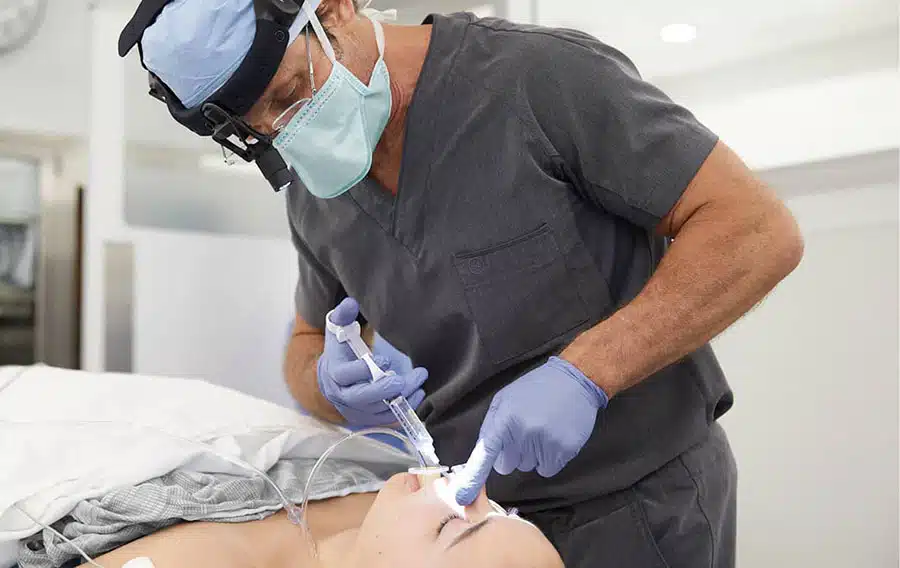
What is Rhinoplasty?
Rhinoplasty is a surgical procedure that reshapes, augments, or reduces the size of the nose for aesthetic or functional reasons.
A rhinoplasty, more commonly known as a nose job, can help even out your facial features while addressing any functional issues like breathing difficulties or a deviated septum. This surgery will treat broken nasal bones, breathing correction, or airway restrictions, potentially caused by a birth defect or accident. The goal is always to ensure an attractive nose shape that complements the rest of the facial features, correcting any asymmetry.
A surgical rhinoplasty aims to create a natural appearance while respecting the patient’s ethnic features and personal aesthetic goals, often through dorsal hump removal.
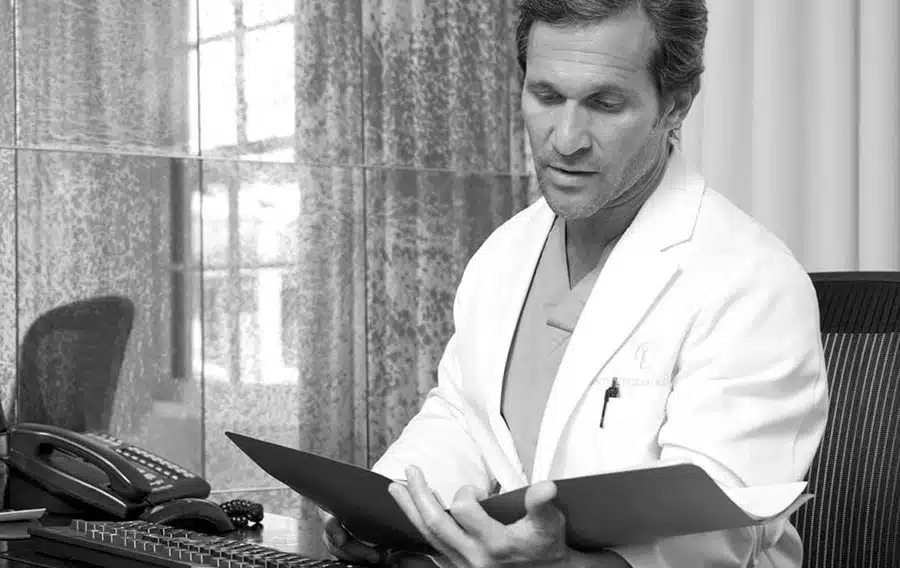
The Rhinoplasty Consultation
During the private consultation with expert and board-certified plastic surgeon Dr. Andrew Frankel, he will have an in-depth discussion with the patient about their goals, expectations, and any previous procedure(s). This is the perfect time to discuss any concerns about using a rib cartilage graft or questions about the alar cartilage.
The doctor will also conduct a pre-operative evaluation of the nose and the overall facial anatomy, and he may also use computer imaging. He will also discuss rhinoplasty expectations, results, methods, and risks, including the benefits of rhinoplasty and what to avoid after surgery.
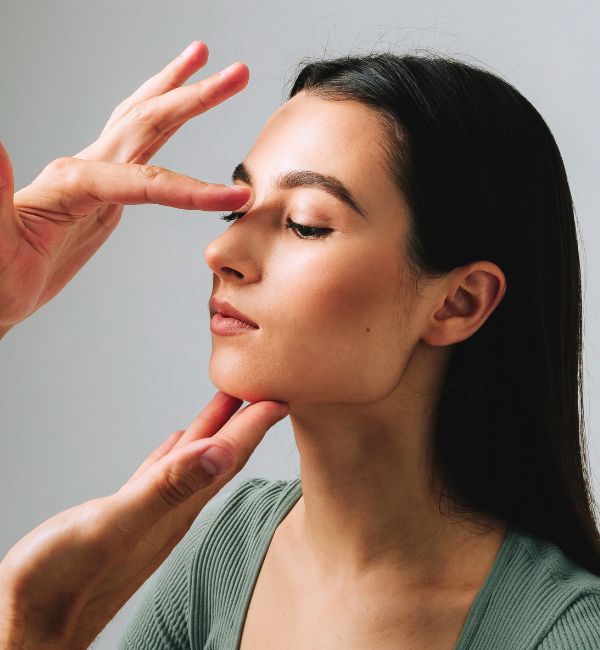
Who is a Good Candidate for Rhinoplasty?
Rhinoplasty isn’t just about looks; it can also help with comfort and confidence.
Good candidates for rhinoplasty are those who:
- Want to improve the size, shape, or balance of their nose to better match their facial features. This includes fixing crooked noses or other shape issues.
- Have trouble breathing or other structural problems with their nose that can be fixed by surgery.
- Have realistic goals and understand what the surgery can and can’t do.
- Are in good health, which helps with smooth healing and recovery.
- Have finished growing (usually age 16 or older) so the nose is fully developed.
If this sounds like you, consider a consultation to see if rhinoplasty can help you reach your goals.

Personalized Rhinoplasty:
Crafting the Perfect Nose for You
At Dr. Andrew Frankel’s Clinic, he specializes in personalized rhinoplasty, harmonizing each procedure with your unique facial features. Using advanced imaging and expertise in both open and closed techniques, Dr. Frankel creates seamless, natural enhancements that respect your aesthetic goals and ethnic heritage. Each step is carefully planned for results that boost confidence while preserving your individuality, helping you achieve an authentic, refined look.

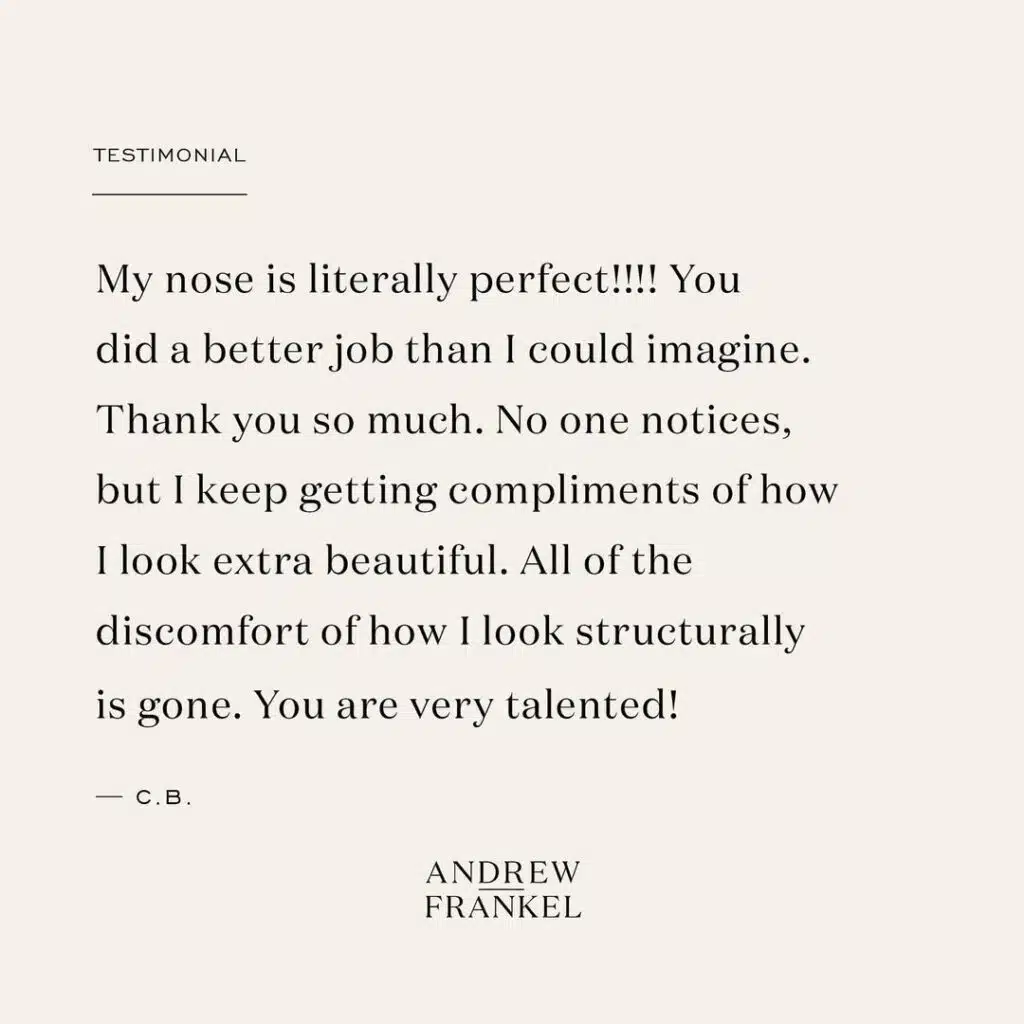

Schedule Your Nose Job with Dr. Andrew Frankel
Beverly Hills’ top rhinoplasty surgeon, celebrated for world-class rhinoplasty results.
Preparing for Your Rhinoplasty Surgery
Dr. Frankel emphasizes the importance of preparation to ensure you receive top-level care. Proper preparation not only helps to mitigate risks but also enhances the success of your surgery. Here are key steps that rhinoplasty candidates should follow:

Medication and Supplements
Avoid certain medications, vitamins, and herbs that can increase bleeding. Dr. Frankel will provide a detailed list of these items, which typically include aspirin, ibuprofen, vitamin E, and certain herbal supplements. It’s crucial to stop these at least two weeks before your surgery.
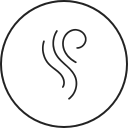
Smoking and Alcohol
Refrain from smoking and limit alcohol consumption in the weeks leading up to your surgery. Smoking can severely impair healing by constricting blood vessels and reducing blood flow to the surgical site, while alcohol can increase your bleeding risk.

Skin Care
Avoid harsh skin treatments such as chemical peels or laser treatments in the days leading up to your surgery. Such procedures can irritate the skin and complicate the healing process.

Rest and Hydration
Ensure you are well-rested and hydrated before the day of surgery. Good physical health supports a smooth surgery and recovery.
By adhering to these pre-operative instructions, you can help ensure a safer procedure and a smoother rhinoplasty recovery.
The Rhinoplasty Procedure Explained
Before your nose reshaping surgery, Dr. Frankel will review your custom surgical plan with you. If you receive general anesthesia, you must refrain from eating or drinking after midnight the night before your surgery.
Other patients may only need local anesthesia with sedation and may be given other instructions.
Making the incisions in your nose
To start the rhinoplasty in Beverly Hills, the doctor will make an incision either externally at the bottom of the nose or inside the nose.
Open Rhinoplasty
Making external incisions is known as the “open approach” and allows the doctor to gain better access and visibility when manipulating the structures within the nose. The small scar is the only downside of this technique.
Closed Rhinoplasty
The “closed approach” involves incisions inside the nostrils, with no external cuts. This rhinoplasty technique may be appropriate for patients who only need small changes, but most nose surgeons favor the open approach for the best results.
Dr. Frankel will go over the surgical technique he plans to use for your procedure before the surgery to ensure you are fully informed and comfortable with the process.
Shaping the Nose
Once the rhinoplasty specialist has made the incisions, he will separate the skin on the nose from the bone and underlying cartilage structures. Then, he will trim the bone and cartilage to create the desired shape. Additionally, Dr. Frankel may create cartilage grafts and place them to enhance the shape of the nose, and sometimes he will use a rib cartilage graft for this purpose. He will then close the incisions and put a splint in place to support the nose’s new shape while it heals.
Dr. Frankel, renowned in Beverly Hills for facial plastic surgery, also addresses complex breathing issues through functional nose surgery. His expertise extends to a variety of nasal surgeries, ensuring personalized care for each patient. He knows how to improve or maintain nasal function when changing the shape of the nasal tissues.
A primary rhinoplasty will take an average of 1 to 2 hours. A nose job is an outpatient basis procedure, so patients can go home with a friend or family member after being cleared by the staff at the Lasky Clinic.
Differentiating Types of Rhinoplasty
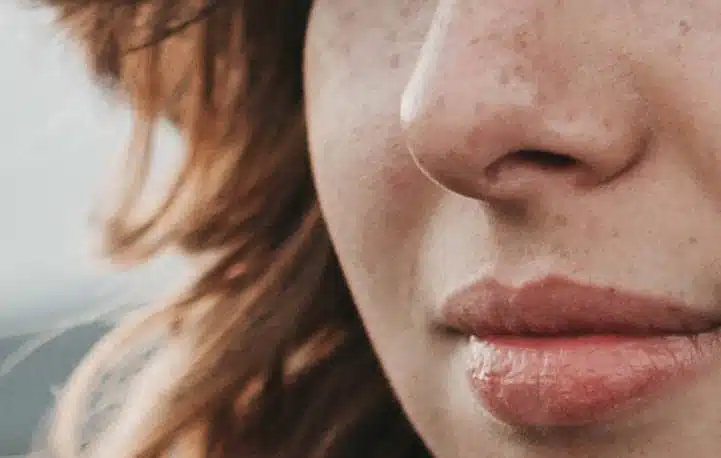
Nasal Tip Rhinoplasty
Nasal tip rhinoplasty is a limited surgery focused on the tip of the nose. There are myriad ways of modifying the tip cartilage’s shape, and this can be done without involving any other nose parts if indicated. While the recovery from this more limited operation might be easier for the patient, refining a tip can be very challenging for the cosmetic surgeon.

Reduction Rhinoplasty
In rhinoplasty reduction, our Beverly Hills physician may reduce the nose’s overall size, or he may make specific areas, like the tip, wide nostrils, a hump, or a bump. This procedure aims to improve the overall facial appearance by achieving a balanced and proportionate look. He will often resize the nose by removing nasal cartilage and/or bone from the nose to achieve the desired shape and size, creating an ideal nose that complements the patient’s features.
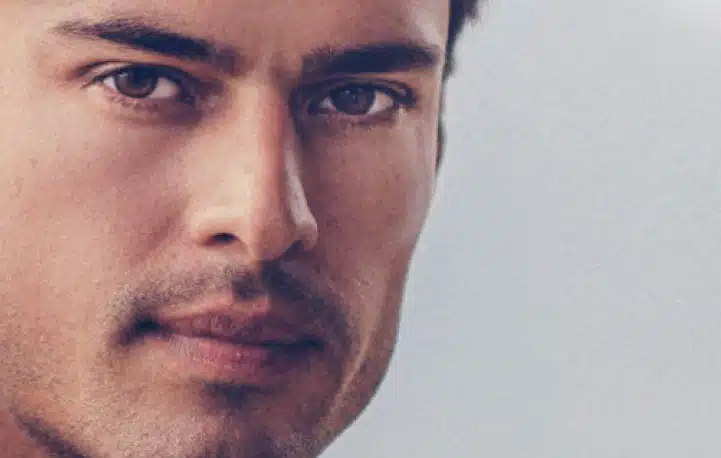
Augmentation Rhinoplasty
Occasionally, Dr. Frankel will need to build up a nose because it has been over-reduced with prior surgery or because of prior trauma or congenital issues. For augmentation of the nose, the doctor will use cartilage from the nasal septum, chest wall, or ear to add support, height, and projection. Considering this rhinoplasty option can help patients achieve a natural-looking and beautiful nose.
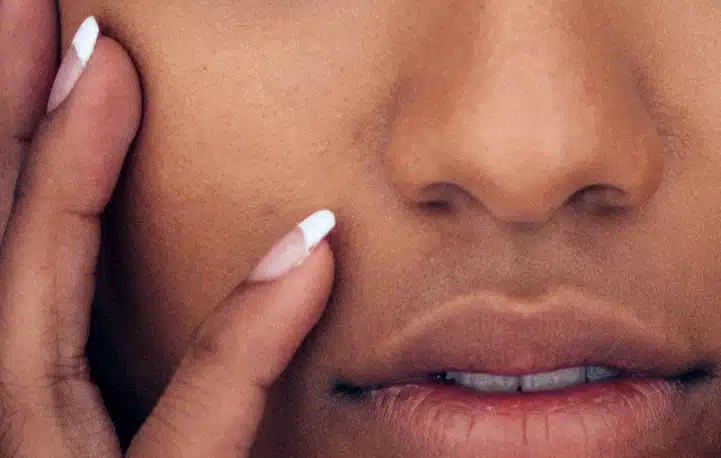
Ethnic Rhinoplasty
Ethnic rhinoplasty enhances the nose’s appearance while preserving features unique to each ethnic background. Specialized approaches, such as African American and Asian rhinoplasty, respect these anatomical and aesthetic nuances for natural, culturally mindful outcomes. Dr. Frankel, a recognized expert who frequently lectures on ethnic rhinoplasty at national conferences, tailors each procedure to harmonize with the patient’s facial structure. His extensive experience attracts patients from diverse backgrounds worldwide.

Functional Rhinoplasty
Due to structural defects, a nose may need to be reshaped to function properly. Patients may be born with congenital defects, develop, or acquire nasal defects that interfere with breathing, eating, or sleeping through an accident or physical confrontation.
Functional rhinoplasties are imperative for fixing a variety of nasal structural abnormalities or injuries, thereby improving breathing function.
If you have difficulty breathing through your nose, the functional advantage of rhinoplasty can be as dramatic as improving your appearance.

Revision Rhinoplasty
Secondary rhinoplasty relates to nasal surgery that improves or corrects the outcome of a previous nose surgery. Because rhinoplasty is such a challenging procedure and healing is not 100% predictable, revision surgeries are quite common, and often patients come to Dr. Frankel after having had several previous surgeries. Obtaining consistent results in revision cases requires a great deal of extensive experience and skill. Dr. Frankel appreciates the trust his patients have in him by choosing him as their surgeon.
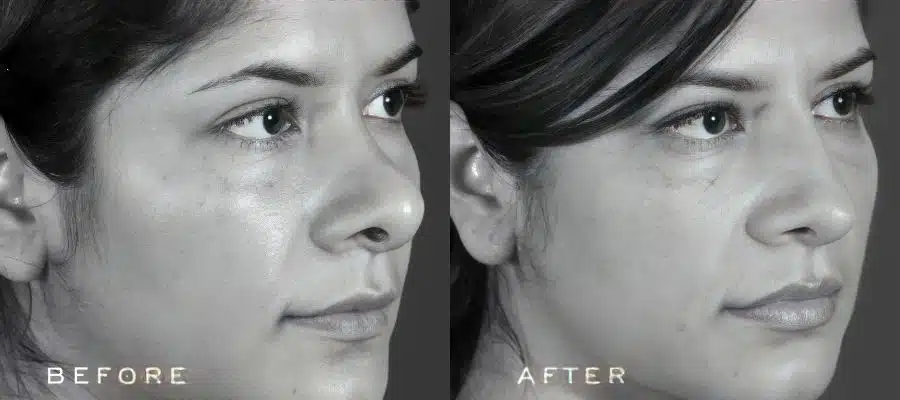
Want to understand more about what to expect on the day of surgery?
What to expect on the day of the Rhinoplasty

Rhinoplasty Anesthesia
Dr. Frankel performs the majority of rhinoplasty operations under the direction of a board-certified anesthesiologist, often involving twilight anesthesia without needing a breathing tube, ventilator, or paralysis. Even in surgeries taking several hours, the anesthetic is well tolerated, and patients wake up quickly feeling very good.

Day of Surgery
The first 1 to 2 hours after a nose procedure are spent in the recovery room on monitors and under the care of a registered nurse. Patients are transferred to private rooms once they are more awake, where their families or friends can join them. Once fully alert, patients can return home with postoperative instructions.

Pain Management
Rhinoplasty is typically not very painful, and most patients experience more discomfort than pain, particularly immediately after surgery while the local anesthesia is still working. While recovering at the clinic, patients may receive intravenous medications to stem any acute pain. Patients are discharged from the clinic with their prescribed medications.

Emotions Management
You will likely feel various emotions before and after surgery: excitement, anxiety, fear, etc. It is normal to have some apprehension before any operation and, in particular, one that will change your appearance. If you are questioning things, Dr. Frankel suggests that you trust yourself and the time and effort you spent deciding to have surgery and choosing the best doctor.
What to expect after Rhinoplasty surgery

Swelling Post Operation
Following surgery, Dr. Frankel will place a splint on the nose, both for protection and to help it maintain its new shape. The nose will be moderately swollen and stuffy for several weeks, and the remainder of the swelling will gradually resolve for the next six to 18 months.

Hydration of your nose
Sleeping with a humidifier can be helpful for the first two weeks after surgery. Once Dr. Frankel gives the go-ahead, use a nasal saline spray to help keep the inside of your nose moist. Using it will minimize your nose’s crust and make breathing easier.

Rest and exercise post-surgery
Rest for the week after surgery and avoid excessive smiling or bending over. Most patients can drive a car and return to work and social activities after eight days. Avoid strenuous/extreme physical exercise for three weeks, as well as contact sports for eight weeks.

Average recovery time
Every patient heals differently. If you notice that a particular behavior or activity is causing swelling, avoid that activity until you have healed. Physical recovery from nasal surgery is fairly quick, but the nose will not achieve its final form for well over a year and you can expect some bruising.
Possible Risks of Rhinoplasty Surgery
Because rhinoplasty is a facial surgery, there are some potential risks involved. For most people, the risk is minimal, especially when a board-certified facial plastic surgeon specializing in rhinoplasty performs the procedure. Risks and complications may include:
- Bleeding
- Breathing problems
- Unfavorable scarring
- Changes in sensation
- Infection
- Poor aesthetic results
- Anesthesia complications
- Skin necrosis
Why Choose Beverly Hills Rhinoplasty Specialist Dr. Andrew Frankel?
Choosing Dr. Frankel for your rhinoplasty ensures expert care from a renowned surgeon dedicated to achieving natural, harmonious results tailored to your unique facial structure.
- Board-Certified Specialist: Certified in both Facial Plastic and Reconstructive Surgery and Otolaryngology-Head and Neck Surgery, specializing exclusively in facial procedures.
- Over Two Decades of Experience: With more than 20 years in practice, he has performed thousands of rhinoplasty surgeries.
- Recognized Excellence: Featured in prestigious publications like Vogue Italia, Cosmopolitan, and The Hollywood Reporter, highlighting his skill and artistry.
- Academic Contributions: Served as Assistant Professor at UCLA and USC Keck School of Medicine, actively involved in clinical research and teaching.
- Innovative Techniques: Continuously refines surgical methods to ensure personalized, natural, and harmonious results.
- Patient-Centric Approach: Dedicated to achieving patient satisfaction with tailored treatment plans that respect individual aesthetic goals and ethnic features.
